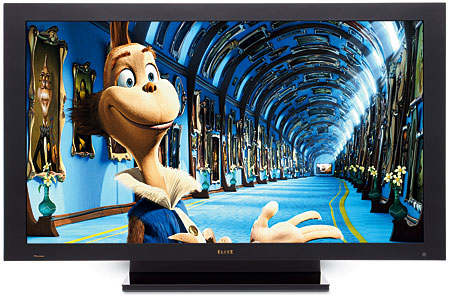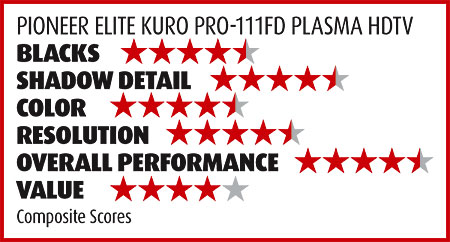Pioneer Elite KURO PRO-111FD Plasma HDTV
Manufacturers of flat-panel plasma televisions have been refining the technology for years. But Pioneer has been particularly successful at it. In the past, the company made some of the world’s best rear-projection CRT sets, and it knew that great black levels are the foundation of a great picture. That philosophy has paid off over the years, particularly in recent-generation KURO sets.

But the technology Pioneer uses in its plasmas makes them among the most expensive sets on the market, a dedication that hasn’t been kind to the company’s market share and bottom line. Beginning sometime in mid 2009, the next generation of KURO sets will use plasma panels manufactured by an outside supplier—Panasonic. The sets will reportedly still include features and technologies that are exclusive to Pioneer. But if you want an “All KURO Inside” Pioneer for your home theater, now might be the time to get it.
KURO Outside
Pioneer offers both standard and Elite KURO sets, with the former offering fewer features. The most significant shortcoming of the standard sets this year is that they don’t offer color temperature options in the user menu, and you can’t calibrate them in a service menu, according to Pioneer. My experience with the standard 60-inch PDP-6020FD KURO (reviewed in the September 2008 issue) wasn’t at all disappointing. In fact, our PDP-6020FD actually had marginally deeper measured blacks than the PRO-111FD tested here—a difference that was most likely caused by inevitable production variations. But if you want the most accurate color Pioneer has to offer, you’ll want a fully calibrated Elite KURO model.

The PRO-111FD has four HDMI 1.3 connections, although it only has a single component input. There’s also an Ethernet port for a home network connection and a USB port. (As with all the sets in this group, the Pioneer will let you display your digital photos and some types of videos.)
 The set’s speakers attach to the sides and are removable if space is an issue. While the judges did not evaluate audio in this Face Off, my own experience with the sets tells me that the Pioneer offers the best sound by a considerable margin—if that is a relevant issue to the potential buyer.
The set’s speakers attach to the sides and are removable if space is an issue. While the judges did not evaluate audio in this Face Off, my own experience with the sets tells me that the Pioneer offers the best sound by a considerable margin—if that is a relevant issue to the potential buyer.
Pioneer calls the preset picture modes AV Selections, and there are seven of them. Dynamic and Optimum are fixed, but the user can reset the video controls for the others. While the Mid-Low preset color temperature setting was reasonably accurate, I performed a full calibration for this test. The Elite series provides full high and low color temperature adjustments in the user menu (and has the capability for 10-step adjustments in an ISF menu with special software that was unavailable to us at test time).
For the tests, we used the Pure mode, in which the set’s color gamut was nearly identical to the HD standard. The Pioneer’s PureCinema control, in any setting, automatically converts 1080p/24 to a refresh rate of 72 Hz by repeating (not interpolating) each frame three times. In addition, when set to Advance, it will convert any film-based source (except 1080p/60) to a display rate of 72 Hz. (This will eliminate 3:2 pulldown in the process.)
The Pioneer’s 480i-to-1080p video processing (tested with a 480i component input) was fair, with some visible jaggies on my standard palette of torture test patterns (mainly on the waving-flag test). It recognized 3:2 pulldown, though slowly, and turned in a poor result on a 2:2 pulldown cadence test (for video-based material). Its 1080i-to-1080p HDMI processing was also good—actually better than reported in the November 2008 review. (I recently dropped one of the three tests we previously used for 1080i 3:2 pulldown because it may produce erroneous results.)
The Judges Speak
Four of the five judges picked the Pioneer as their favorite set, and a big reason was the depth and richness of the set’s blacks. “Best of the bunch,” one wrote. It drew a lot of favorable comments not only on its black levels but for its shadow detail as well. In fact, out of the first three finishers in this category—the Pioneer, Sony,
and Panasonic—the comments about the Pioneer’s performance for both of these important characteristics were the most consistently positive.
 Although the Sony went deeper on a full black image, the Pioneer drew high praise from most of the panel for the best reproduction of both dark and near dark scenes, particularly on its inky look into the depth of space in the star field from Stargate: Continuum. One judge commented that only on the Pioneer and Sony could she see that a few of the stars were red instead of white.
Although the Sony went deeper on a full black image, the Pioneer drew high praise from most of the panel for the best reproduction of both dark and near dark scenes, particularly on its inky look into the depth of space in the star field from Stargate: Continuum. One judge commented that only on the Pioneer and Sony could she see that a few of the stars were red instead of white.
The Pioneer’s deep black foundation also contributed to its fine sense of image depth. One judge commented that she could see textures in dimly lit details better than on the other sets, including the best facial textures in the dimly lit Russian stargate facility scenes in Stargate: Continuum.
“The best on pretty much every clip,” commented one judge. He said, “In a field of black, the Sony could look pretty darn good, but once there was both shadow and light, this Pioneer won hands down. Consistently the best.” He continued, “The Master and Commander clip was pretty awesome. I’m used to a well-calibrated CRT rear-projection set, and they do shadow detail very, very well.”
“Deep, rich, and earthy colors,” commented one judge after viewing the Pioneer on Legends of the Fall. He also praised the rich, comic-book-like colors on The Incredible Hulk and how well the set distinguished the subtle shades of a horse’s mane in Hidalgo. Another commented on the natural skintones, which were redder than the tones on the Samsung and Sony. But he said they didn’t put an extra red tinge on clouds.
On Hidalgo, one panelist wrote that the Samsung looked a bit more dimensional in the brightest scenes, although he rated both excellent in this regard. This may relate to the fact that an LCD (like the Samsung) will look brighter on bright full-screen images than a plasma. But this is never overtly visible and was the only time in the test that anyone made a comment that might be due to this characteristic.
The positive comments far outweighed any criticisms. “Everything looked natural, and The Incredible Hulk, with its heightened color palette, looked awesome,” noted one judge. Another observed that the Pioneer “always has the best detail, clarity, and pop, even off axis. Colors always jump but are never garish.”
The panel praised the Pioneer for its smooth performance on motion. One judge noted that it produced the cleanest detail on horizontal motion, holding small details in the background and foreground.
However, another felt that the set lost detail in the pan across the thatched roof at the beginning of Shakespeare in Love. He also commented on visible noise in some scenes, particularly large areas of solid color or white. Another viewer, however, while noting the noise, felt that this was simply the Pioneer’s detail resolution bringing out noise in the program material. This panelist praised the Pioneer’s performance on standard- definition material. During Legends of the Fall, she remarked, “Surprisingly crisp with excellent contrast. This is standard definition?”
Conclusions
The two comments from the panel on visible noise in some images needs further comment. When setting up the test, I noticed that when viewed from very close to the screen, some images (particularly those with large areas of solid white, gray, or color) clearly showed a random, dither-like noise. No other set had this (not even the Panasonic), so it isn’t a universal plasma characteristic. But I could not see it from the normal viewing distances we used in the test. Apparently, three of the five panelists didn’t notice this either since they did not comment on it.
Apart from that, the Pioneer totally wowed the panel. Four out of five judges ranked it first overall. It also ranked first in all four of the rated performance categories. (It tied with the Sony for blacks.)
Most of all, it consistently handled all of the program material. Perhaps one judge summed it up best when he commented, “Fantastic. Everything looked awesome. The high-def stuff was the best I’ve ever seen.”















































